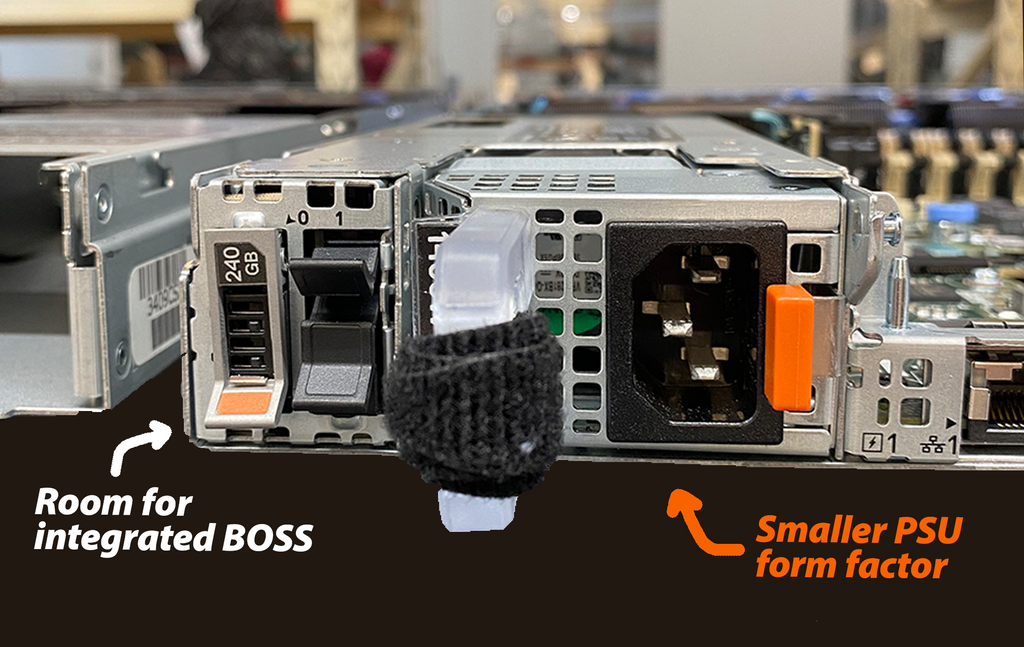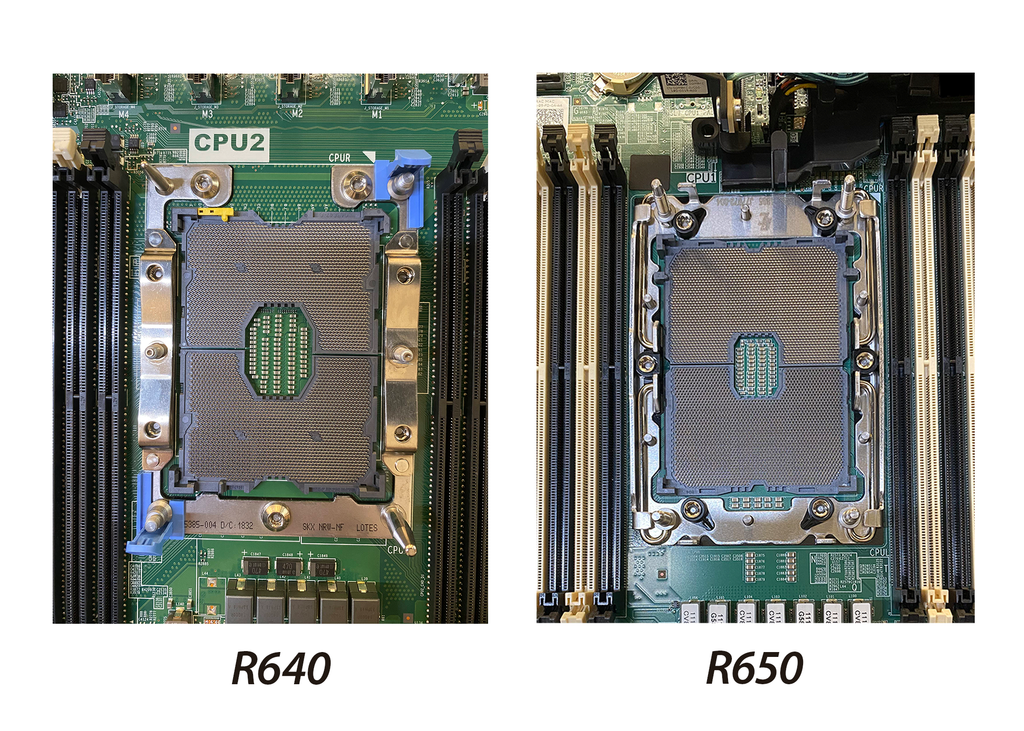Dell PowerEdge R640 vs. R650 — What's the Difference?

A quick look at the specs sheet for the Dell PowerEdge R650 reveals some pretty significant improvements from its predecessor, the R640. The two share features including Intel’s scalable processor architecture, a 12Gbps hard drive backplane, DDR4 RAM, etc, but Dell gave the R650 a few big boosts. In this blogpost, we’ll talk you through the major differences between the R640 and the R650 and discuss what these changes mean for networking, processing, and overall performance.
Smaller PSU → More Room in the Back
Dell introduced a new, more efficient power supply unit (PSU) form factor for the R650. The new PSU is significantly smaller and saves a good deal of space at the rear of the server. This new design seems to be what allowed for a lot of components in the back to be shifted around.
Big change 1: Integrated BOSS
One major upgrade: the R650 has integrated BOSS (Boot Optimized Storage Solution). As the name suggests, BOSS is a dedicated storage solution designed to optimize booting the operating system. In the case of the R650, the integrated BOSS comes in the form of an m.2 SSD (which the smaller PSU left room for). Note that there are two slots you can use for installing/running the OS, which can be setup in RAID 1 so that if one fails, the other can keep things moving. This allows for uninterrupted uptime in case of an BOSS SSD failure and overall improved system responsiveness.

In R640s, BOSS can be added via PCI-e slot. So the best part of having integrated BOSS in the R650? A now-free PCI slot to use for other adapter cards, networking, external storage, or whatever (compatible) device your heart desires.
Big change 2: Better NVMe Support
The R650 comes with much better built-in support for NVMe (Non-Volatile Memory Express) storage via the H755 or H755N RAID card. NVMe is a storage protocol specifically designed for SSDs that offers several advantages over traditional storage options.
One key benefit of NVMe is its significantly faster data transfer speeds compared to traditional storage interfaces like SATA. NVMe leverages the PCIe (Peripheral Component Interconnect Express) interface, enabling direct communication between the storage device and the CPU. This direct connection minimizes latency and allows for much higher data transfer rates, making for improved storage and overall system performance.
Quick tutorial: How to use NVMe drives in an R640
It’s certainly possible to set up your R640 for NVMe use. But as opposed to the R640, the R650 was designed to fully harness the capabilities of NVMe storage; that means optimized data transfer pathways, reduced latency, and parallel processing. On the storage performance potential front, we think this addition makes the R650 outperform the R640.
Big update 3: Memory, Memory, Memory
The R650 takes a pretty massive leap in memory with 32 DIMM slots, compared to the R640's 24. The R640 offers up to 3TB of RAM with load-reduced DIMMs, while the R650 raises the bar with an impressive maximum memory capacity of up to 12TB. Not bad, not bad at all.
Big update 4: Support for Faster Processors

The R650 offers support for 3rd Generation Intel® Xeon® Processors, a step up from the R640 (which only supports up to 2nd gen processors). This upgrade unlocks CPUs with more cores, pins, and faster bus speeds. To take full advantage of this, the PCIe slots also needed a speed boost, so the R650 got https://techmikeny.com/collections/configure-to-order-servers to match. Gen4 doubles the maximum bandwidth for PCIe, making it possible to hook up more powerful peripheral devices like high-performance graphics cards, network adapters, storage controllers, etc.
Assembly Tip: The R650’s new retention lever also makes it much easier to carefully install processors.
Other changes:
-
New fan design
Where the R640 fans are single rotor, the R650 uses dual counter-rotating rotors. With support for faster procs, the change makes sense. While this does mean more frequent fan replacement in the event of malfunction, counter-rotating fans do help avoid dead spots and allow somewhat quieter operation.

Dell also added new tiers to high-performance fans, with options now including high-performance Silver-Grade and high-performance Gold-Grade.
-
LOM (LAN on motherboard)
The PowerEdge R650 has 2 x 1 Gb LOM, while the PowerEdge R640 does not have a specified LOM.
Shop TechMikeNY Dell PowerEdge R650
-
NDC no more
Where the R640 has an NDC, the R650 now has a new adapter card called the OCP 3.0. OCP3.0 offers a more open and standardized approach compared to proprietary rNDC. (What OCP3.0 is and why it matters.) It includes simplified power supply architecture, basic systems management, and complete compliance specifications with industry-wide consistency. OCP3.0 also improves thermal performance, power capability, and adds Hot-Plug capability, allowing for operation in high-availability systems. Additionally, OCP3.0 is more compact, enabling users to stack PCIe and OCP3 slots in a 1U server design, whereas two PCIe cards would not fit.
-
Removable I/O board
The I/O board is now removable! So if it fails, you can replace just that module. Way more affordable and much less of a hassle than having to replace the whole server motherboard.
If you're curious about the full feature by feature generational comparison table, you can check it out here: Dell PowerEdge R650 Technical Guide (see page 8)
In Summary...
Bottom line - with its faster processors, beefed up memory, and high-speed storage, the https://techmikeny.com/collections/configure-to-order-servers blows the R640 out of the water. The new PSU form factor allowed for upgrades like swappable I/O that make this server built to last. So for IT pros ready to step up their infrastructure's performance, we’d say the R650 is definitely an upgrade in terms of storage and delivers way more power for running top-tier workloads.
Looking to configure an R650 but not quite sure where to start? Talk to the nerds at TechMikeNY and we’ll help you out. Just email info@techmikeny.com, call (718) 635-9880, or drop us a line in the comments below.


